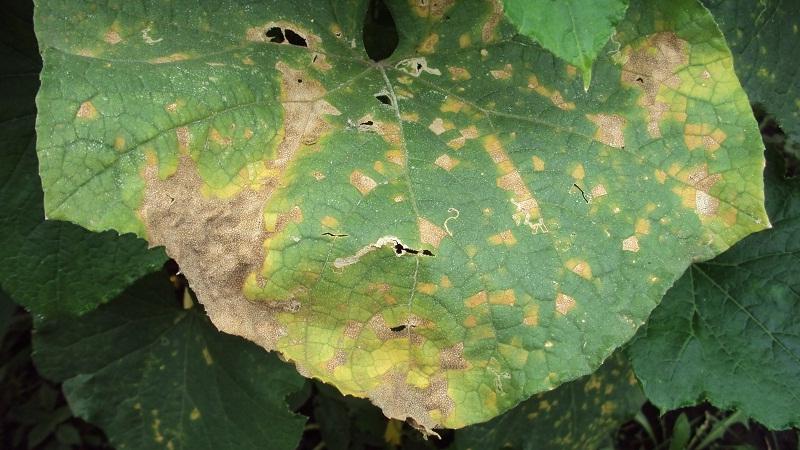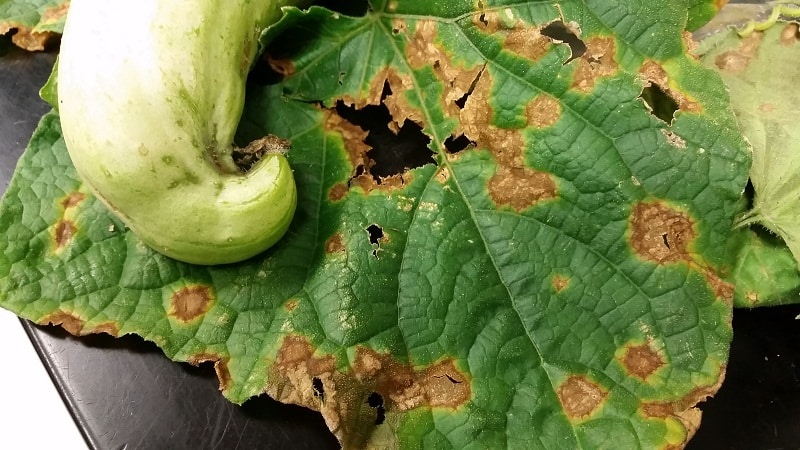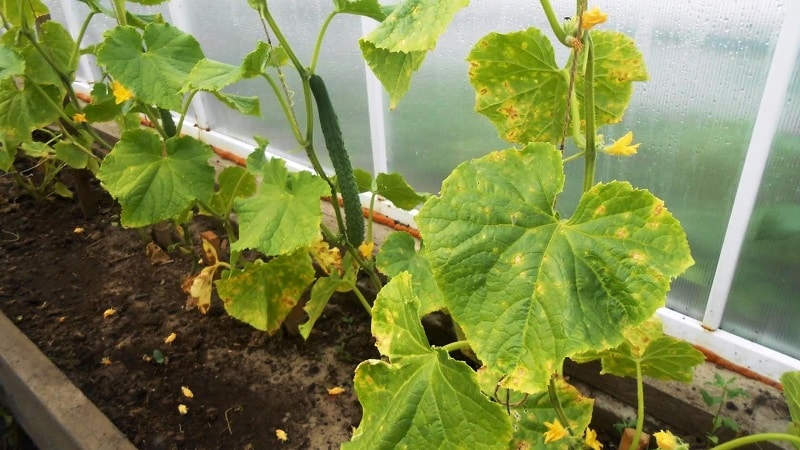Why rusty spots appear on cucumber leaves and how to deal with them
In summer, in gardens you can often see rusty spots on the leaves of cucumbers. There are many reasons for this phenomenon. Cucumbers are finicky plants and require proper care. It is important to properly care for the crop to prevent yellowing of the leaves.
Why rusty spots appear on leaves and what to do to prevent them from occurring, you will learn from this article. Gardeners will share their personal experiences and tell you how to get around the problem and grow cucumbers without loss.
Causes of rusty spots on cucumber leaves
Cucumbers come from tropical forests with a humid, warm climate. This factor must be taken into account when starting to grow crops in the garden. Violation of the usual growth conditions leads to various problems. One of them is that rusty spots appear on the leaves of cucumbers. There are several reasons for this phenomenon.

Diseases
Why do cucumber leaves have rusty spots? The first reason is fungal illnesses, such as cladosporiosis, anthracnose, ascochyta blight, downy mildew.
To determine what disease attacked the plantation, inspect the leaves:
- If the leaves have light brown spots and the lower part is covered with cobweb-like mycelium, then this is a lesion cladosporiosis (olive spot). The disease progresses at high humidity and low air temperatures. Young shoots and fruits are most often affected.
- If depressed brown spots appear on the root collar, the plant is sick anthracnose. The disease affects the leaves - smooth red spots appear on them. This disease is sometimes called verdigris. The main reason is water falling on the leaves of the plant during watering or rain.
- Often found in greenhouses ascochyta blight (black stem rot). The stems of cucumbers become covered with large spots, which are initially green. Over time, the spots turn brown and the fruits rot. The ascochyta fungus does not live in the soil; it reproduces only through seed.
- Another disease that affects cucumbers in a greenhouse is corner spot. Plants become covered with oily green spots. Over time, they acquire a rusty tint, holes appear in the leaves, and the fruits become covered with whitish ulcers.
- Another problem is peronosporosis. It is also called downy mildew. Yellow spots appear on the top of the sheets. Gradually they grow, acquiring a rusty tint, and the cucumber tops dry out.
Attention. Fungal diseases actively develop at high humidity and are often transmitted through seed material.
Nutrient deficiencies
Rust on cucumbers can be caused by a lack of nutrients, as this leads to a weakened immune system of the plants.
When growing a crop, fertilize according to the following scheme:
- After the fourth leaf appears, apply nitrogen fertilizer. Ammonium nitrate is suitable for this. Dilute 2 tbsp. l. saltpeter in 10 liters of water. Water 0.5 liters per bush.
- Second feeding carried out after 2 weeks. At this time, the plant gains green mass. Take 0.5 kg of yeast, 1 liter of old jam and dissolve in a bucket of warm water. Place the solution in a warm place for several hours to ferment. To feed, 1 liter of the mixture is diluted in a bucket of water.Water 0.5 liters of fertilizer under each bush.
- During the flowering and fruiting period, they switch to phosphorus-potassium fertilizers, continuing to fertilize every 15 days. You can prepare the mixture in the following proportion: 1 tbsp. l. superphosphate, 2 cups of potassium chloride, 0.5 cups of wood ash. Dilute water in a bucket, water 0.5 liters per bush.
- Organic lovers use humus or compost. You can also use pharmaceutical preparations - brilliant green, hydrogen peroxide. These products not only nourish cucumbers, but also serve as antiseptics, protecting plants from diseases.
Attention. Fertilizers are applied after watering so as not to burn the root system.
Pests
Sometimes red spots on cucumbers are caused by spider mites. This pest appears in hot weather and feeds on the cell sap of the plant.
To help get rid of it:
- weeding beds;
- moistening the beds in hot weather;
- the drug "Fitoverm" for severe damage.
Dry leaves can be caused by melon aphids. It settles on the inside of the leaves, sucking the juice from them. A solution of baking soda, water and laundry soap (1 tablespoon of soda per 1 liter of water) will help fight aphids. Soap is used to help the solution stick.
How and with what to treat

There are different ways to deal with rust. It is important to remember that fungi thrive in moist environments. In this regard, it is worth carrying out a number of measures to save cucumbers:
- stop watering for a week;
- when the temperature drops to +15 °C, cover the beds with oilcloth;
- thin out the beds to improve ventilation;
- lighten the soil structure by fertilizing with hydrogen peroxide (dilute 2 tablespoons of peroxide in 1 liter of water and water 0.5 liters per bush).
Chemicals
Chemicals will help get rid of rust on leaves: Bordeaux mixture or copper oxychloride. Treatment is carried out 3-4 times during the growing season and at the beginning of flowering. Severely affected areas are wiped with a solution of copper sulfate.
Traditional methods
Those who do not want to use chemicals in their garden can fight with traditional methods. But activities must begin even before planting the seeds.
Procedure:
- After the fourth leaf appears, spray with a solution of brilliant green. It is prepared at the rate of 10-15 drops per bucket of water. They work on all sides, water the soil between the rows and near the plants.
- At the first signs of disease, the leaves are irrigated with a weak solution of slaked lime or wood ash diluted in water (a glass of ash per bucket of water).
- They use tinctures of garlic and celandine - fill half a bucket of herbs with water and leave for a day. Spray the plants in the evening.
Preventive measures

The most effective method of combating rust on cucumbers is prevention. You can pre-treat the plantation with fungicidal drugs (Benomyl, Chlorothalin) or carry out other preventive measures:
- disinfect seed material before planting with a solution of potassium permanganate for 30 minutes;
- treat the soil with Fitosporin before planting seeds;
- warm the soil with boiling water;
- fertilize the beds before planting seeds;
- observe crop rotation - do not plant cucumbers in the same place for several years in a row;
- regulate watering, prevent dry soil;
- mulch the soil between the rows;
- remove weeds in a timely manner;
- water at the roots, without touching the leaves.
Tips and recommendations from experienced summer residents
Experienced gardeners know why rusty spots appear on cucumbers.
Peter, Kaluga: «I carry out preventive maintenance before planting seeds in the ground. I soak the seed in a solution of potassium permanganate and water the beds with boiling water before planting. When the cucumbers sprout, I fertilize them with ammonia (1 tbsp per bucket of water). In the future I feed every 2 weeks. I also spray it with a solution of brilliant green (10 drops per bucket of water). I never have red spots on cucumber leaves.”
Masha, Orsk: “I always have a rich harvest. To avoid stains on cucumbers, you must follow agricultural practices. I water it 3 times a week so that water does not get on the leaves. At the beginning of the season I add ammonia, then a mixture of superphosphate, wood ash and potassium salt. I prepare the beds for planting in advance, adding compost, rotted manure, and peat.”
Read also:
A promising and high-yielding hybrid of cucumbers "Kibria".
conclusions
A common problem encountered in gardens is rusty and yellow spots on the leaves of cucumbers. The main reasons are fungal diseases and pests. Disinfecting the soil and seeds with a solution of potassium permanganate will prevent the disease, and watering at the root will prevent it from spreading. You can fight rust on leaves using chemicals or folk remedies.